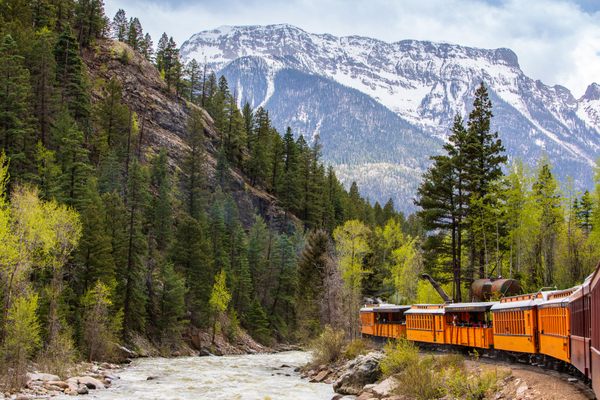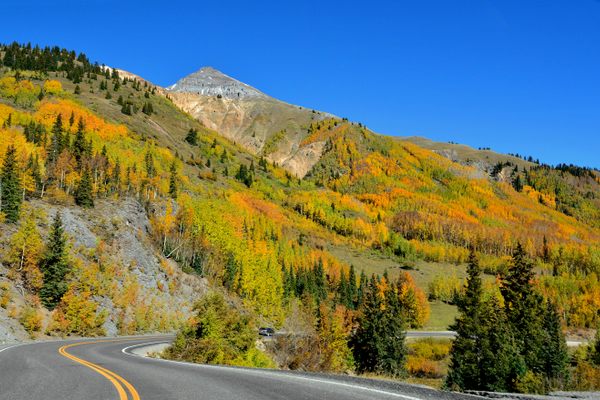Why Build Your Railroad Around a Castle When You Can Just Go Through It?
Runaway railway expansion helped inspire Britain’s preservationist movement.

In the 19th century, Northampton Castle, even as a ruin, had the mystique that only a castle built a millennia ago, during the reign of William the Conqueror, can evoke. Its old stone walls had a fuzz of greenery growing from their uneven edges, and even half-collapsed, they towered over visitors. In one corner, the base of a round tower still stood, and the graceful arches of windows and doorways held strong. Built outside the walls of London, surrounded by earthen bulwarks, the castle was the backdrop to the trial of Thomas Becket in 1164 and survived intact until 1662, not long after the Restoration, when King Charles II ordered part of it destroyed.
The ruins endured for another 200 years, until the railway came through in the 1880s. The castle’s last owner searched its grounds for treasure, then sold the land to the London & North Western Railway Company, which knocked down the walls and built a train station on the site. The company named the stop “Northampton Castle.”
Northampton Castle was not the only aged landmark that the railway companies demolished as they sprawled across the British landscape. Over the preceding decades, centuries-old city walls, abbeys and priories, medieval castles, and stone circles like Stonehenge all came down as tracks were laid through.


Some people saw this as progress: In 1839 one railway chairman told Parliament that the companies had every right to level anything that stood in the way of their expansion. (He conceded that Westminster Abbey could probably stay standing.) But as that expansion and other development projects accelerated, some people began to worry about what was being lost. If they couldn’t preserve the slower pace of life they were accustomed to, they reasoned, at least they could save the monuments that evoked those earlier times.
“Paradoxically it was the advent of the railways that helped to promote the conservation movement,” writes historian Jeffrey Richards.

Wealth also helped drive this movement, since rich people didn’t like when the trains cut through their land. To modern-day developers, this is a predictable problem, but in the early 19th century this particular brand of backlash was still new. When, in the early 1830s, a railway company proposed building a new line from London to Birmingham, local landowners, including at least a couple of earls, gathered at public meetings to protest the proposal, and the danger it posed to the ruins of Berkhamsted Castle in Hertfordshire.
Like Northampton, Berkhamsted dated to the 1060s; its first owner was William the Conqueror’s half-brother. A motte-and-bailey castle, it had a keep built on a raised land, enclosed by a wall and surrounded by a moat. In the uproar over the train line, the castle became enough of a cause célèbre that it is mentioned by name in the 1833 act of Parliament that authorized the railway’s construction. (The original act, in 1832, was rejected.) When the line passed through the castle’s grounds, the act said, it could not deviate more than 100 yards from where it was authorized to be. Berkhamsted has the distinction of being the first landmark in Britain to earn protection from the government.

But that victory for the landowners did not set a clear precedent. In the 1840s, a growing movement of preservationists continued to fight the railways as they snaked across the land.
Some fights they lost. Richards, the historian, recounts examples—city walls in Chester and Newcastle, an Iron Age fort, a Roman camp, the stone circle at Shep—where development took precedence over preservation. In 1844, a railway went straight through the Priory of St. Pancras, the oldest house in England from the monastic Cluniac period.

In other cases, the activists won concessions. The railway cut through the city wall of York, but was given a nice-enough archway to pass through. In another case, when the Society of Antiquaries of Scotland opposed the destruction of Trinity Church in Edinburgh in 1848, the railway provided £22,000 (around £2.5 million or $3.2 million today), to reconstruct it elsewhere.
The movement scored some victories, too. A railway proposed to cut through Furness Abbey, a moody ruin, instead skirted its edge. Local protests convinced Parliament to pass a special act protecting Maumbury Rings, a circular Neolithic henge in Dorset. Gradually, members of Parliament were convinced that the country needed a more wide-ranging policy to deal with threats to these ancient landmarks.

It wasn’t only the railways that finally prompted Parliament to act. Sir John Lubbock, the leading politician of the preservation movement, personally bought some of the land that the Avebury stone circles stand on to protect it from housing construction as a nearby town expanded. It took years for him to convince his colleagues to approve an act that would protect ancient monuments. “Have you heard of the threatened invasion of Stonehenge by a Railway Engineer?” one local clergyman wrote to him. The proposed line was to run diagonally across the site’s Cursus, a mysterious earthwork close to two miles long and more than 5,200 years old. “What is to be done?” the reverend wrote. “If anybody can put a spoke in the wheel you can; but I fear the Ancient Monuments Bill will not include the Cursus!”
The efforts of the movement finally resulted in the Ancient Monuments Protection Act, which passed in 1882. The act listed around 50 sites in Britain that the government claimed some guardianship over, and created the position of an inspector tasked with keeping them safe. (The Cursus wasn’t originally listed by name, but it was spared development.) It also empowered the government to buy the sites under threat. While preservationism was growing popular elsewhere in the world—Americans, for instance, were interested in safeguarding some sites related to the Revolution—Britain’s was one of the first landmark preservation laws ever written.


















Follow us on Twitter to get the latest on the world's hidden wonders.
Like us on Facebook to get the latest on the world's hidden wonders.
Follow us on Twitter Like us on Facebook